Goodbye, Syd Mead



Sad news to report tonight: legendary production artist Syd Mead passed away earlier today at age 86 (obituary). He leaves behind an enormous body of work that has inspired millions and helped define how we envision the future.
Mead began his career in 1959 as an automotive artist, envisioning what the next generation of cars might look like for the Ford Motor Company. In 1961, he struck out on his own as a freelance industrial artist. For three decades, he helped create what would become a familiar look for the future in marketing materials for companies ranging from old standards like US Steel and Atlas Cement to up-and-coming electronics concerns like Sony and Phillips. In the late 1970s, he expanded his oeuvre to include film production concepts and quickly established himself as one of the best in the business. Whether or not you've ever heard his name, odds are you must know some of his concepts, an unreal list of credits that includes Star Trek's V'Ger, Aliens' USS Sulaco, Short Circuit's Johnny 5, 2010's Leonov, Blade Runner's futuristic Los Angeles, TRON's Light Cycles and countless other key visual elements elements that helped define classic genre films. To those that knew him, he was considered exactly as down to earth as his visions of the future were not and is celebrated as someone who made a point of sharing his skills and experience with up-and-coming concept artists, helping to inspire a sense of cooperation instead of competition in the field.
Wing Commander fans may also know that he developed the initial alien concepts for Wing Commander Prophecy. There's no doubt that countless fandoms across the internet are putting together similar remembrances of his involvement in the creation of their worlds and in that spirit we would like to share a brief history of his involvement in Wing Commander. While Origin's marketing made sure that Syd Mead's name was closely associated with the game from its announcement, many people are unfamiliar with what he actually did for the project. Much of this confusion stems from the games' marketing material seemingly promoting Mead as the visionary behind the entire game and some from Origin's Official Guide to Wing Commander Prophecy incorrectly crediting him for some of the game's storyboards, set designs and human ships. In short, Syd Mead was responsible for establishing the look of both the alien spacecraft and the creatures themselves. His work took the form of 2D concept sketches and contrary to popular belief he did not design every spacecraft. Instead, his job was to provide examples early on from which in-house artists would derive additional ships; conversely, he did much more work on the Nephilim creatures themselves than ever appeared in the game.
Wing Commander IV shipped in February 1996 and it quickly became clear that the next iteration of the series would not be business as usual. Chris Roberts departure to form Digital Anvil cost Origin's Maverick team some of its most experienced talent and made Electronic Arts nervous about Wing Commander's future viability. In the interim, artists who did not leave to join Digital Anvil were tasked with assisting other teams working on projects like Ultima IX, Wing Commander IV Playstation, Crusader: No Regret or a number of other unrealized products (including pre-production on Silverheart and Hazardous Duty, a Wing Commander FPS). The pre-production phase of Wing Commander Prophecy, then called Wing Commander V, began in late April 1996 and continued for several months as Electronic Arts held the team in limbo deciding on a new management structure and overall direction for the product. One bright spot of this restructuring period was the appointment of the team's new art director, Mark Vearrier. Vearrier was a veteran of Dynamix projects like Nova 9 and Aces of the Pacific who had gone on to work as a 3D artist on Wing Commander III and IV. Now he was tapped as the lead charged with managing what would eventually become the next game's eleven-person art team For the next four months, he would continue to prove his mettle by overseeing the initial concepts for Wing Commander V's human ships as well as side projects like the new Origin logo animation, the Kilrathi Saga introduction and scheduling for the soon-cancelled Maniac Missions spinoff.
During this time, the topic of bringing in an outside concept artist to help define the look of the series new enemy aliens was brought up. This would serve two purposes: it would give the team fresh material to expand upon as production geared up and it would provide an Electronics Arts' marketing group concerned with the impact of Chris Roberts' departure on players with a 'name' that could be promoted as being involved with the project. Syd Mead, then already a legend, was among the names discussed. Vearrier reached out to Mead who seemed interest and the idea sat dormant for several weeks. At the end of August, the conversation resumed and Mead agreed in principal to work on the project. Hammering out the formal agreement took more time than was expected but by mid-October the contract was signed and Mead's timeframes had been established. As a contract artist rather than in-house talent, Mead would would work remotely from his studio in Detroit, Michigan and provide specified deliverables to Origin in Austin, Texas via mail. The process would be collaborative, with Vearrier providing an initial brief and rough sketches which Mead would develop into full blown concept drawings. As email had yet to become ubiquitous, Vearrier would provide feedback to Mead via phone meetings between iterations of the artwork. Per the agreement, Mead would have three major deliverables: examples of alien capital ships, examples of alien fighters and concepts of the alien creatures themselves. This sort of arrangement was common for films but unusual for games in 1996; it has since become the norm with projects like Star Citizen bringing in top film talent to define their overall look early in development.
The first package of artwork from Detroit arrived at the end of October and large 18"x24" printouts of the pieces were hung in the Maverick team's conference room and hallway for feedback from the larger team. That feedback would be collected and then passed to Mead by Vearrier. The team was very happy with the overall look to the point that work on building the first Mead-designed model in Alias, the next step in the process for creating individual ship assets, began immediately rather than waiting for his final delivery. It was a happy case of the first direction being the right direction and the next two months would see an ordinary back-and-forth to provide feedback and drill down on different ideas. By the time the development team broke for Christmas in 1996, Mead's final artwork had been delivered and the game had moved into full production.
In terms familiar to the average Wing Commander Prophecy combat pilot, Mead was directly responsible for the design of the Kraken ship killer and the Manta and Moray fighters. These pieces would be modeled in Alias by production artists at Origin and then roughly twenty additional ship designs would be derived from their appearance. Mead explained his process: "The Aliens, I thought, should incorporate a queasy level of organic growth detail which would look appropriately weird and also indicate an exotic method of manufacture. The [fighter] cross section is axially hexagonal. The 'capital ship,' is immense in story scale, measuring about fifty kilometers in length. The command level is at the top. The spherical front end opens in an iris-like maw that can spew out hundreds of bio-mechanical fighter ships to form a frightening attack."
In addition to his defining work on the game's alien ships, Mead was also responsible for a considerable amount of work on the alien (later called Nephilim) characters themselves. While the aliens appear only briefly in the game on comm VDUs and in a short cutscene, the game's designers sought to lock in a much fuller concept of them which was to have been applied forward to future stories. In total, Mead designed three different castes of aliens: drones, lieutenants and queens. The drones would appear as the game's normal pilots (though they were never modeled in Alias), the lieutenants are the 'warlord' aces which kidnap Commodore Blair and the queens would not be included in the game at all (though they were sometimes referred to as the 'mother creature' in taunts). Mead describes his process for imagining the aliens: "Creating the alien characters for WING COMMANDER V was a challenging exercise in combining several morphologies, something I have been doing since childhood. I have always been fascinated, for instance, with the mythical horseman creature known as a centaur. The Alien character set had to reflect a hierarchical social and command structure. What more natural 'fascistic' model than the colony-mind genetic imperative so elegantly exemplified by ants, bees and wasps. The bottom social order were the solder Aliens following the 'worker bee' and the 'drone' example. I decided on a six-legged physiology, using the rear set as the primary weight and mobility support. Having thus established a kind of bipedal locomotion, the middle pair of legs became an additional mobility assist when rapid turning or climbing was required. The forward set became the 'arms' with a kind of hand gesture and grasping function. The middle hierarchy were the Lieutenants. This level had a vestigial 'royal' carapace growth at the junction of head to thorax. And the 'queen' commander class had an elaborate carapace with distinctive silhouette 'points' on either side of the carapace. To further distinguish these royal variations, only the queens had the additional identifying characteristic of carrying weaponry mounted into the carapace plate."
Although Origin would not develop additional alien designs, Mead remained proud of the work. In 2001, he published an art book titled Syd Mead's Sentury which included a look at some of his Wing Commander artwork. He would also go on to incorporate some of the alien pieces in his regular convention slideshow, sharing the work directly with interested audiences around the world. Mead would note that he never personally saw the final application of the designs because as a Macintosh user he was never able to play the finished game.
Syd Mead's influence on Wing Commander came late in the game but it was unquestionably significant. In addition to defining the new enemy, his alien aesthetics were used in much of the promotion for the game and his name was routinely mentioned in interviews. In a better world, his artwork for Wing Commander Prophecy's new enemy would have inspired multiple future games and his work on the deeper background of the aliens themselves would have become an essential part of the universe. Of course, it's still possible that could happen someday! Regardless of Wing Commander's future, Syd Mead leaves behind a legacy of unparalleled visions that are unlikely ever to be equaled; he will be missed.











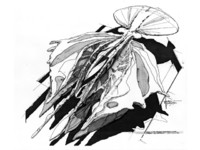


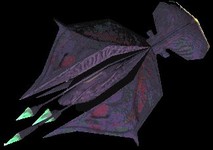







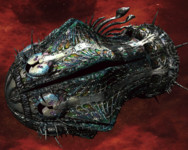







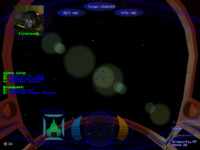

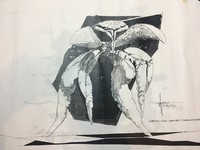
























Follow or Contact Us